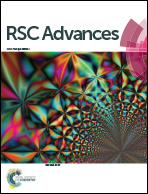Real-time monitoring of self-assembling worm-like micelle formation by organic transistors†
Abstract
Thanks to their appealing rheological properties, nowadays micellar solutions play a fundamental role in many industrial sectors, including personal care products, cosmetics and pharmaceuticals. The use of these solutions and their effectiveness in the desired application is, however, strongly dependent on the specific micellar aggregation form and the related degree of entanglement. To this end, it should be mentioned that, still today, the type and size of the micellar aggregates in a solution can be only investigated by using sophisticated laboratory techniques, which are very difficult to be applied directly in real industrial production sites. In this study, we demonstrate that organic electrochemical transistors (OECTs) based on PEDOT:PSS active channels can be used to reveal the presence of worm-like micelles in surfactant–salt aqueous solutions. In the worm-like regime the response of these devices displays distinctive features in comparison with those exhibited when pure surfactant solutions, containing only spherical micelles, are analysed. Our results could pave the way to the development of a new class of portable and user-friendly devices, suitable for the in situ monitoring of morphological transitions, involving micellar aggregates.


 Please wait while we load your content...
Please wait while we load your content...